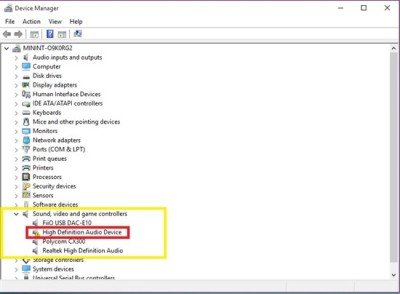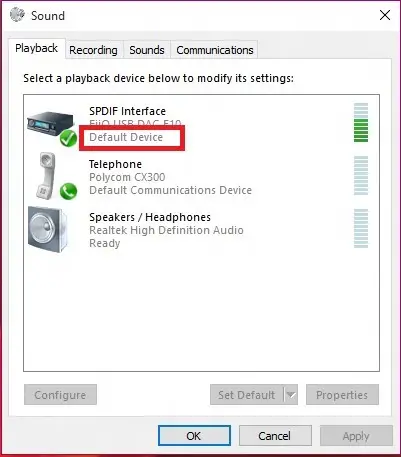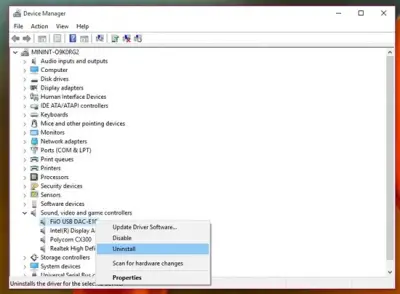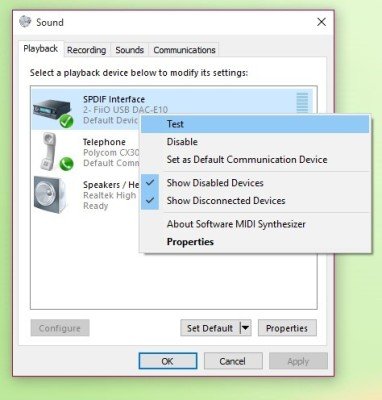Microsoft has received good reviews for their latest OS –Windows 10. The OS is packed with new features, apps and functionality that intends to make your computing experience a smooth affair. However, the OS brings with it its own share of problems, issues and bugs. Several are reporting sound and audio problems like – Windows 10 sound is not working properly, unable to play videos, use certain apps, or hear anything at all from their speakers. Let’s see how to resolve this, and other Windows 10 Sound and Audio problems.
Windows 10 already includes Playing Audio Troubleshooter and Recording Audio Troubleshooter, which you can easily invoke via the Control Panel, the Taskbar Search or the Troubleshooters tab of our freeware FixWin 10.
Windows 10 Sound and Audio problems & issues
Here are some suggestions from Microsoft, which can help you carry out the troubleshooting manually, depending on you specific issue.
Windows 10 sound not working
First, check the manufacturer’s web site for updated drivers. You could also open Windows Update and look for driver updates. If it’s an external device, like headphones or a USB device, unplug and plug-in the device. If your device is a USB, try a different port. Also disable Audio Enhancements and see if it helps.
If you find that the problem persists, uninstall your audio driver and reboot to let Windows reinstall it automatically or uninstall your audio driver and try using the inbox HDAudio driver.
For other scenarios, try different fixes. Let’s cover them in detail.
Poor audio quality; bad sound
In this scenario, the initial troubleshooting step is the same as above i.e. check for driver updates from Windows Update. If your device is USB, try a different port or try disabling audio enhancements, if applicable. If all these fail, uninstall your audio driver and try using the inbox driver (HDAudio)
Speakers, Bluetooth, Headphones not working
In this case, it may be so that you are able to play music over your built-in laptop speakers, but as soon as you plug in your wired headphones, audio continues to be played over the speakers (or no audio plays at all). To solve this, uninstall your driver and reboot to allow Windows to reinstall it. If this fails, uninstall your audio driver and try using the inbox driver (HDAudio).
Try different Audio Formats
Often, incompatibilities with drivers or the audio software in Windows affect audio playback or recording so, it becomes essential to confirm if audio format issues are the source of your issue.
Switch to Control Panel, and click the “Sound” link. Thereafter, run “mmsys.cpl” in your search box or command prompt.
Right-click on the sound icon in your system tray and select “Playback Devices”
Right-click your “Default Device” and click “Properties”
Switch to the “Advanced” tab and try changing your Default Format a few times. This should solve the problem.
Check Device Manager
Device Manager displays information about the driver profile for all the hardware devices present on your system. Verify, if any audio devices have problems already identified by the system. To do so,
Type “Device Manager” in search box adjacent to the start menu, and hit Enter. Expand the “Sound, video and game controllers” tab.
Uninstall your audio driver and use the built-in Windows Audio driver (HDAudio).
Microphone does not work
Here, you may discover that Cortana refuses to hear you. You may find that plugging an external microphone into the computer or using a headset works better. Try the above-mentioned solutions.
If nothing works for you, you may report your specific problem to Microsoft, including in your question the make and model of your PC,your hardware ID and driver version of your audio device, whether playing a Test Tone worked, a screenshot of your “Sound, video, and game controller” tab in Device Manager, and report if when your device is trying to play audio by noting whether green volume bars are present in the Sound Control Panel.
How to do all the above? Microsoft has also laid down detailed instructions on that!
How to find Device ID & driver version of your audio hardware
To do this, run Device Manager. Go to Sound, video and game controllers. Here, Double-click your audio device. Next, switch to the Details tab and select Hardware IDs. Thereafter, right-click to copy the IDs and then paste them somewhere. Finally, select Driver version, right click to copy and then paste the contents in a Notepad.
How to uninstall audio driver
Initial troubleshooting step involves identification of your default device driver. For this, go to the Sound Control Panel, click the “Sound” link.
Run “mmsys.cpl” in a command prompt. Right-click on the sound icon in your system tray and select “Playback Devices”.
When done, in the Sound Control Panel, verify which device is your system default and return to your desktop.
Next, type “Device Manager” in your search box and click on the Device Manager app. Expand the “Sound, video, and game controllers” tab.
Now, right click your default audio device driver, and click uninstall.
How to play a Test Tone
Playing a test tone helps you determine if your machine’s audio subsystem has any function at all.
To play a test tone, go to the Control Panel, and click the “Sound” link. Next, run “mmsys.cpl” in your search box or command prompt. Then, right-click on the sound icon in your system tray and chose “Playback Devices” option.
In the resulting window, right-click on your “Default Device” and select “Test”. If everything is working well you should hear test sounds playing out of your default audio device.
Check if Green Bars are visible
To do so, navigate to the Control Panel, and click the “Sound” link. Again Run “mmsys.cpl” in your search box or command prompt.
Right-click on the sound icon in your system tray and select “Playback Devices”. Play some audio, and look at your “Default Device”. You should see green volume bars.
Hope something helps you.
see also : Wi-Fi does not work after upgrading to Windows 10
see also : How To Install Language Packs In Windows 7
see also : Troubleshoot Windows 10 Sound and Audio problems
see also : Quick Access in Windows 10 is not working
see also : Windows 10 cannot connect to Internet
see also : Troubleshoot Windows 10 Activation Errors: List of error codes and fixes
see also : Windows 10 Installation or Upgrade Errors: 80240020, Something Happened, etc
see also : Cannot activate Windows 10. Product Key blocked
see also : Office documents do not open after upgrading to Windows 10
see also : Nividia releases new WHQL drivers
see also : INACCESSIBLE BOOT DEVICE error in Windows 10
see also : Fix: Windows 10 Settings app does not open or launch
see also : Windows Store not working in Windows 10 – Automated Fix
see also : Windows Store apps not opening in Windows 10
see also : Start Menu does not open or not working in Windows 10
see also : Wi-Fi does not work after upgrading to Windows 10
see also : How To Install Language Packs In Windows 7
see also : Troubleshoot Windows 10 Sound and Audio problems
see also : Quick Access in Windows 10 is not working
see also : Windows 10 cannot connect to Internet
see also : Troubleshoot Windows 10 Activation Errors: List of error codes and fixes
see also : Windows 10 Installation or Upgrade Errors: 80240020, Something Happened, etc
see also : Cannot activate Windows 10. Product Key blocked
see also : Office documents do not open after upgrading to Windows 10
see also : Nividia releases new WHQL drivers
see also : INACCESSIBLE BOOT DEVICE error in Windows 10
see also : Fix: Windows 10 Settings app does not open or launch
see also : Windows Store not working in Windows 10 – Automated Fix
see also : Windows Store apps not opening in Windows 10
see also : Start Menu does not open or not working in Windows 10





No comments:
Post a Comment